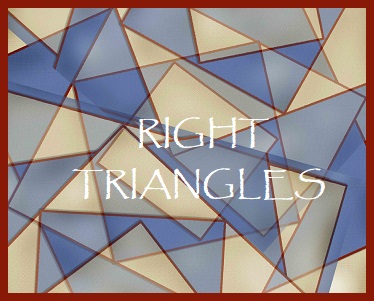
OUR REMOTE MATHEMATICAL INHERITANCE
 |
OUR REMOTE MATHEMATICAL INHERITANCE |
Carlos Calvimontes Rojas
With attachment to the truth of proven facts, Western culture owes much to the
ancient Rome and Greece, but it must be recognized that they were, at best,
intermediaries of the knowledge of remote cultures, especially that of Sumer.1
The very wide diffusion of the interpretation of which in a Mesopotamic tablet
there is a series of triplets of right triangles2,
has done of current importance the demonstration of which a right triangle: "the
sum of the squares of the catheti is equal to the square of the hypotenuse ",
formulated in the school created by Pythagoras (ca. 569 - ca. 475 BC) in the
famous theorem that takes the name of that Greek philosopher and mathematician
and that is the formal and universal verification of the geometric conditions of
any right triangle, demonstration found in the Elements of Euclid (ca. 325 BC -
ca. 265 BC), Greek mathematician and geometer.
It should be emphasized that 'the square of a number' in antiquity was not
interpreted as a 'number multiplied by itself' as it is now, but considering the
figure of a 'geometric square'.
It is necessary to remember that Pythagoras was more than twenty years in trips
of study in Egypt, Mesopotamia, Byblos, Tire, Syria and India; therefore, it is
entirely possible that he has known the configuration of right triangles in
Mesopotamia and in Egypt, in the way described by Gudea.
The architect best known in the remote antiquity of Sumer: Gudea (2144 - 2124 or
2122 BC) 15 centuries before Pythagoras, he would have instructed that in his
famous sculpture known as the Architect with Plans carves the procedure to know
the values with integers of the sides of right triangles without relation to
figures of 'squares'3,
surely for the interest of that culture to square construction works of
different proportions. In addition, ten centuries after Gudea and five before
Pythagoras, in the tomb of Ramses IX (11th century BC) a right triangle 3-4-5
formed by a human figure and a snake4
was recorded, showing the solution of that type of triangles in the same way as
Sumer did.
For everything previous, it is been wrong to say that the recent interpretation
of a Babylonian slat with triplets of right triangles is an authentic innovation
and, in addition, that contests the validity of the Theorem of Pythagoras,
because:
·
Gudea was the creator of the algorithm by which we can deduce the dimension of
one of the sides of a right triangle if we know the measurements of the other
sides that are integers.
·
In ancient Egypt, a millennium after Gudea, the same procedure was recorded in a
place of veneration, probably because of the value attributed to that knowledge
for its usefulness in construction
·
Pythagoras contributed the formal and universal verification of the geometric
conditions of any right triangle, since it was verified when it was known how to
obtain the square root of the numbers.
Con ese contexto es necesario poner en su justa medida ‘nuestra remota herencia
matemática’ en el centro de lo que en forma tan amplia se ha difundido en tiempo
reciente, incluso con titulares que distorsionan gravemente el legado de
Pitágoras5.
With this context it is necessary to put in its proper measure 'our remote
mathematical inheritance' at the center of what has spread so broadly in recent
times, even with headlines that seriously distort the legacy of Pythagoras.
1.
The history begins in Sumer,
Samuel Noah Kramer's work
2.
Mathematical mystery of ancient clay tablet solved.
3.
Solution of the
Rigth Triangles according to Gudea's Theorem
4.
Geometry in the ancient
Egypt
5. Pythagoras: Everyone knows his famous theorem, but not who discovered it 1000 years before him.
urbtecto@gmail.com